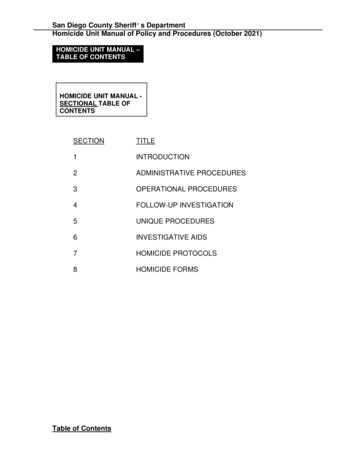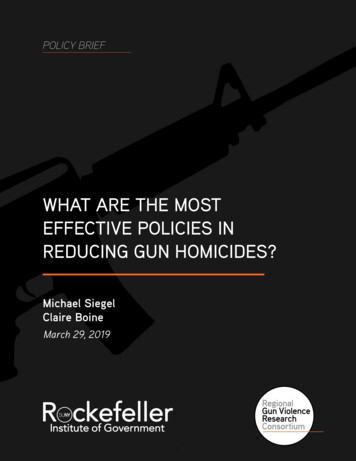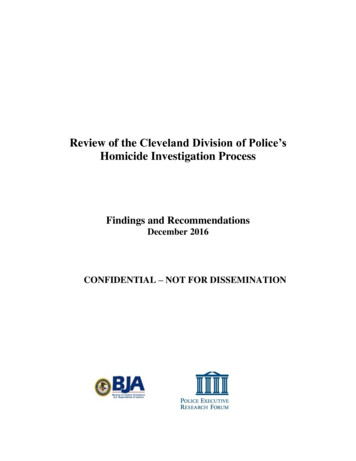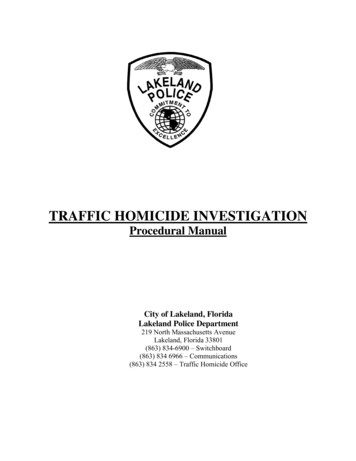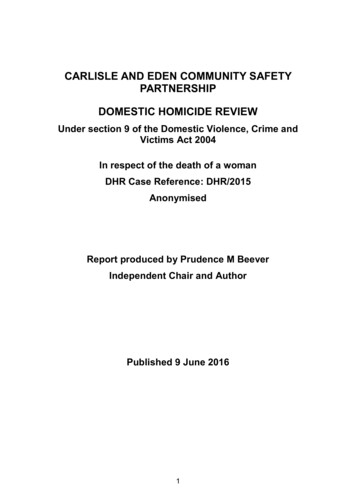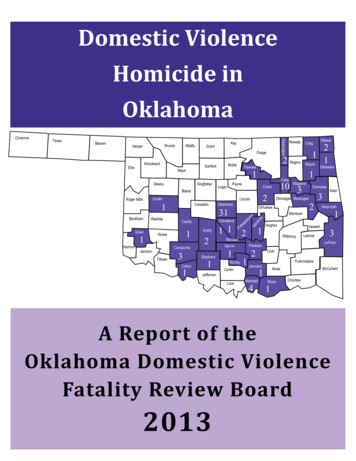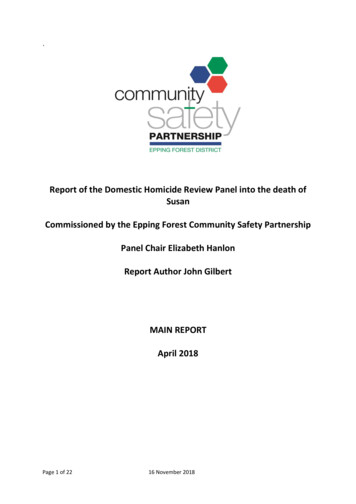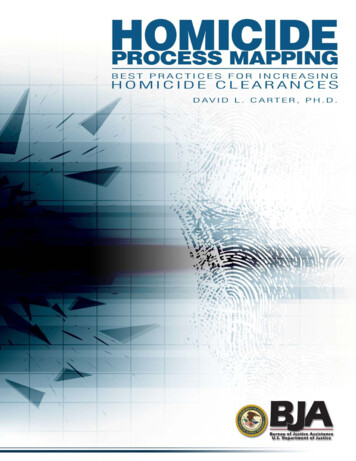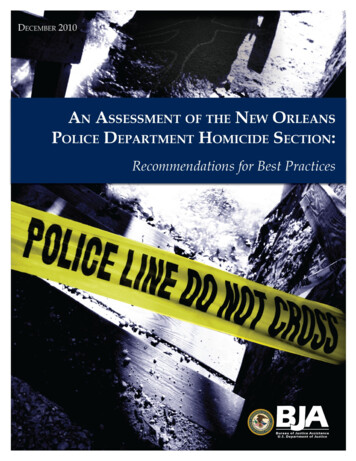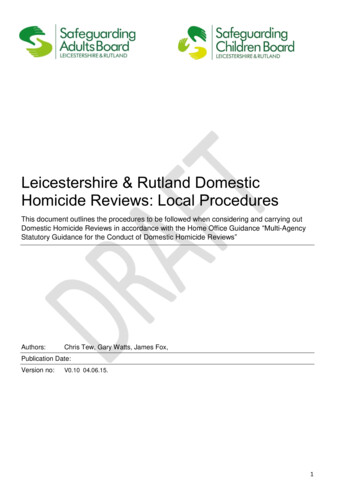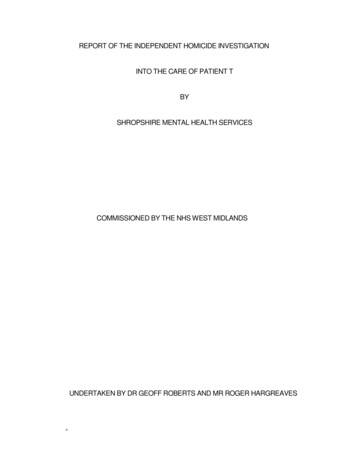
Transcription
REPORT OF THE INDEPENDENT HOMICIDE INVESTIGATIONINTO THE CARE OF PATIENT TBYSHROPSHIRE MENTAL HEALTH SERVICESCOMMISSIONED BY THE NHS WEST MIDLANDSUNDERTAKEN BY DR GEOFF ROBERTS AND MR ROGER HARGREAVES1
AcknowledgementsThe authors thank the staff of the Shropshire PCT and the General Practitionersinvolved in this review for their assistance and very open approach. In particular,Doreen Hancock for her help in co-ordinating the collection of evidence and arranginginterviews. A consistently recurring them in the review was the caring attitude andprofessionalism demonstrated by all those involved.The authors would also like to thank the sister of Patient T for her contributions andassistance and would like to express their condolences to her.2
Table of Contents1.0 Executive summary. 42.0 Terms of Reference . 73.0 Chronology of significant events . 84.0 Analysis of Care and Treatment . 325.0 Recommendations . 43Appendix 1 Job titles of people interviewed . 44Appendix 2 Documentation reviewed in the preparation of this report. 45Appendix 3 The authors . 46Appendix 4 Recommendations for the conduct of internal inquiries from the Michael AbramIndependent Investigation . 473
1.0 Executive summary1. . The Department of Health issued guidance on 10 May 1994 on the care of mentallydisordered patients discharged into the community in the circular HSG (94) 27, LASSL(94) 4. This included guidance on the conduct of external reviews where a patient hasbeen convicted of homicide. This advice was modified in June 2005 and now allows forconsideration to be given for a proportionate Independent Investigation and increasingthe discretion of the statutory agencies in the format and nature of the independentinvestigation. This review was carried out in the context of these changes.2. . The independent investigation has been carried out in line with the Terms of Referenceissued by the Strategic Health Authority and this report is the result of the review.3. . In May 2006 Patient T was convicted of manslaughter for the killing of his mother on 3October 2005 at the home which they shared. A plea of diminished responsibilityresulting from mental illness was accepted and he was made the subject of a Section37/41 order under the Mental Health Act 1983. He is currently in a medium secureclinic.4. Patient T had a long history of mental health problems. He first came into contactwith mental health services in 1989 when he was serving a prison sentence for assault.No definite diagnosis was made until 1996. At this time he was serving another prisonsentence for the grievous bodily harm of his mother and actual bodily harm of hisfather. This conviction was in 1993. After a further conviction for an assault on twoprison officers he was assessed by the Forensic Psychiatrist as suffering from aparanoid psychotic illness.5. . Patient T was eventually transferred to Reaside Clinic for treatment and transferred toShelton Hospital in 1997. After his expected date of release from his prison sentence inJanuary 1997, his detention continued on a notional Section 37 of the Mental HealthAct 1983; this being the only legal option available. However, this meant that therewere no restrictions on him after the Section 37 expired or was rescinded.6. . After his transfer to Shelton relationships with his parents were restored. The hospitalstaff came under increasing pressure to allow Patient T to have leave at his parents.This became more so after his father died in 1998. The hospital staff were wellaware of the potential for this to have significant risks and their efforts to restrict thisare well noted on many occasions in the records.7. . Patient T moved to live in a supported flat in Market Drayton in 2000. This continueduntil 2002 when there was a fire incident at the flat. He was readmitted on a Section4
3 in October 2002, but this was rescinded after four weeks.8. . Despite considerable efforts by his care coordinator to find suitable accommodation,this did not prove possible. The reasons for this and the functioning of theaccommodation funding panel are discussed in more detail in the full report.9. . The default whilst waiting for suitable accommodation became that Patient T lived withhis mother. His care was carefully monitored during this time. In the latter part of 2004and early 2005, there were signs of a relapse of his condition which weresuccessfully managed in the community by the consultant psychiatrist, carecoordinator and GPs. A feature of this period was the ready and intensive input ofall his care workers. The exacerbation was associated with an overuse of procyclidine,a drug used to counter some effects of his depot medication.10. . In August 2005, there appeared to be a further episode of instability which appeared tobe successfully monitored and treated.11. . After killing his mother and for the purposes of a court report, Patient T described anoverwhelming episode of hearing voices on the day of her death. He stated thathe had not informed his mental health workers of this on the day, as he thought hecould and would deal with it himself. Sadly, he did not.12. . Following the incident the Trust carried out an Internal Review using the input of apsychiatrist from another Trust. The review eventually reported in June 2006. Thereview recommendations, although laudable, did not directly relate to or flow from mostof the facts of the case. The requirement for independence of the personnel carrying outan internal review has been examined by the independent investigation and analternative procedure recommended.13.It is the opinion of the independent investigation that the members of theCommunity Mental Health Team (CMHT) involved in Patient T‟s treatment actedappropriately and could not have foreseen or prevented this homicide at the time.14. . The independent investigation benefitted from the input of Patient T‟s sister to whom weare grateful and would like to express our condolences.15. . The independent investigation has made 7 recommendations in the following areasStaff trainingPatient accommodation and proceduresCPA reviewsTrust internal investigation procedures16. . At the trial the Judge questioned whether Patient T‟s mother should have been allowed5
to make a decision to have her son back at home. The reality of the evidenceexamined by the independent investigation has shown a complex picture ofrelationships and co-dependencies between mother and son. The most likely outcomein this case was that Patient T would return to his mother‟s home, sooner or later,irrespective of the wishes or warnings of the professional staff looking after him. Therewould have been insufficient legal grounds to prevent this from occurring.6
2.0 Terms of ReferenceIndependent Investigation into the Care and Treatment of Patient T1. . To examine the circumstances and events relating to the treatment and health care ofPatient T by the Shropshire County Primary Care NHS Trust, Shropshire‟sCommunity Mental Health NHS Trust and organisations where relevant, and inparticular the treatment and health care in the period leading up to the incident at 03October 2005.2. . To identify any systemic or professional problems in the treatment and health careprovided to Patient T. For example:Quality of the assessed riskAssessment of risk of potential harm to himselfAssessment of risk of potential harm to others3. . To consider the effectiveness of interagency working, including communicationsbetween the mental health services, police etc. with particular reference to thesharing of information for the purpose of risk assessment.4. . To review the internal investigations into the care of Patient T already undertakenby the County Primary Care NHS Trust, Shropshire‟s Community Mental HealthServices NHS Trust, any action plans that may be formulated, including the immediateremedial action taken at the time of the incident, or action taken as a result of theinternal investigation and assess the effectiveness of their implementation.5. . To employ Root Cause Analysis principles and techniques to enable competency forlearning to be realised from the investigation.6. . To prepare and produce a report on the above, including any recommendations forfuture action the panel finds it appropriate to make, for publication by the StrategicHealth Authority.7
3.0 Chronology of significant events(Direct quotations from documents are italicised)Date of Birth 31 August 1959Personal Development1. . Patient T was born after a normal pregnancy. There was no family history of mentaldisorder, epilepsy, criminality, violence or substance abuse. He developed asthma atthe age of two which continued until he was 14. This led to hospital admission on twooccasions.2. . He attended local schools and obtained two CSEs at 16 in English and Social Studies.3. . After leaving school he worked in a number of jobs for short periods. He undertookoccasional casual work through the country travelling to pop festivals, hitchhikingand sleeping rough or living in bed and breakfast establishments. From 1987 he wasliving on unemployment benefit and was financially supported in part by his parents.4. . Patient T formed a relationship with an older woman and they had a daughter who wasborn in 1980.Criminal Record5. . Patient T had 21 convictions prior to 1993, mostly for dishonesty or criminal damageand including two convictions for driving with excess alcohol. His convictions includedan assault occasioning actual bodily harm in 1982, a more serious Section 20 woundingof a stranger in June 1989 for which he received a prison sentence of 15 months. Thevictim required plastic surgery.6.In March 1989 Patient T was examined by a consultant psychiatrist who noted:‗A history of consistent cannabis abuse since age eighteen was gained, and a moderateintake of alcohol and occasional use of LSD. He had difficulty describing himself or histemperament in any way. The consultant psychiatrist did not find evidence of mentalillness but felt that Patient T‘s difficulties in obtaining and maintaining work, relationships,difficulties with his parents and other behaviour may be secondary to a personalitydisorder which may be exacerbated by chronic cannabis abuse.Patient T‘s mother told the consultant that on the night before the offence he hadbeen walking up and down the stairs in the home all night. The following day he stayedin bed until 2pm and she noticed that he was abrupt and irritable. Earlier that day she feltthat he was off-hand towards her.‘7.June 1989, the summary of the court reports included:‗Of special note is that it was difficult to discuss the offence with Patient T. Patient Ttold her that he had left a public house after consuming three pints of beer. A842
DRAFTFORaskedCOMMENTACCURACYfriend hadhim if ONhe wasdrunk. This surprised Patient T who went homebut mulled over what he perceived to be a perplexing remark, and he returned tothe public house to ask his friend what he had meant. Instead he met the victim. PatientT said that the victim addressed him in an accusatory way, saying "hello, can I helpyou?" Patient T then assaulted the victim who was physically handicapped.The victim sustained a fractured cheekbone and other injuries.Patient T‘s mother described her son at that time as having consumed a lot ofcannabis, narcotics and alcohol. The Probation Officer described him at her interviewsas "remote", "detached‖, staring fixedly ahead; there was evidence of paranoia in hisperception of remarks made initially by his friend and subsequently by the victim.‘8.Patient T was examined by the Prison Medical Officer in May 1989 whoconcluded that there was no evidence of mental disorder.Substance use9.Patient T began to smoke cannabis heavily during his 20s, but stated in 1993that he stopped doing so in 1988. He had occasionally taken LSD and on oneoccasion hallucinogenic mushrooms, but denied involvement with cocaine,amphetamine or heroin. He drank alcohol from the age of 17, frequentlyconsuming 15 pints of beer in a public house, which sometimes led to actuallymemory loss and occasionally aggressive behaviour.13/3/90Psychiatrist to GP‗I reviewed Patient T at the out-patient clinic today. I was impressed by howmuch brisker and alert he was than when I saw him at Shrewsbury Prison. TodayI could find nothing to suggest an organic disorder and can only conclude that hehad previously been in a state of chronic cannabis intoxication. He is now feelinga good deal better than when he consulted you and does not therefore wish tohave a CT head scan. I think this is a reasonable decision. The only evidencethat links cannabis with cerebral atrophy is a study done in Bristol some yearsago, which has not been confirmed. In any case even if we were to find thatPatient T has minimal cerebral atrophy, it is not going to help in hismanagement.‘28/11/90Referral letter by GP‗This gentleman asks if he might see you again. You saw him in out patients inMarch of this year subsequent I believe to seeing him in Shrewsbury prison.There was a question of drug abuse and a suggestion that he had a CAT scanthough this was shelved as he felt better.He has been working in Somerset as a plastic moulder but came home becauseof headaches and disturbance of vision.On examination he was normotensive and his fundi were normal. He washowever exceedingly vague and slow in thought raising the possibility ofcontinued drug abuse (though he denied this).In view of his new symptoms he feels that he ought to have the CAT. scan.‘9
DRAFT FORCOMMENTON ACCURACY22/1/91Psychiatristto GP‗Thank you for re-referring Patient T. He complains of headaches but they donot have the characteristics of those associated with intracranial raisedpressure. However, in addition, his thinking is very laboured, his speech slightlyslurred and his grasp impaired. He could not recognise simple absurdities, andfound it very difficult to stick to or follow the point. I cannot say whether thesecognitive problems are congenital or acquired, and if acquired, whether throughexcessive drink or drugs. Although he denies ever taking drugs by injection, Isuppose Aids is another remote possibility to be considered if no other organicdisorder is found. At all events I think it is worth doing a CT scan (normal) and Iam therefore arranging it.‘14/6/91Psychiatrist to GP‗Thank you for your letter about Patient T. As you know he turned up at the outpatient clinic without an appointment. Regrettably, I did not have enough time toassess him fully. Nevertheless, in view of the odd attacks he describes, I amarranging for an EEG to exclude the possibility of a temporal lobe focus. Hedescribes seeing apparitions and then shaking violently. However, getting amore accurate account of these episodes is extremely difficult because he tendsto wander off in a discursive way which is very difficult to follow. He certainlygives the impression of a man with limited intellectual faculties, although his CTscan was normal.I will review him when the result of the EEG is available. (Normal)‘10.July 1991. At Glastonbury Magistrates Court: convicted of the assault of astranger. He was fined 100 and ordered to pay 75 compensation. A probationreport prepared for the trial in 1993 states that Patient T‟s account of this wasthat he was living rough in the area, looking for work, and he saw a local manlooking at him. Patient T then confronted the man, asked him what he was doingand hit him three times.7/10/91Referral by GP‗I am sorry that Patient T did not keep his last out patient appointment. Hismother is still very concerned that there is something drastically wrong withhim. He denies having taken drugs for well over two years. He feels himself tobe possessed by an evil spirit which he said entered his body about two and ahalf years ago when he was sleeping rough in a barn in Somerset. This spirittalks to him particularly at meals and at times controls his breathing.He seems to have read widely about what it might be using the word incubusto describe the spirit; perhaps this is part of the problem. He had wonderedabout consulting a medium to see if they could help. He has alreadydiscussed his symptoms with a local clergyman who didn't feel able to offerany further adviceHe didn't seem particularly keen to see you again I wondered whether thesymptoms I have described might fit with early schizophrenia. Do you know ofany other agency that might be able to help him?‘10/10/91Psychiatrist to GP‗Many thanks for your letter about Patient T. You will know from earlier10
DRAFT FORCOMMENTthatONthereACCURACYcorrespondenceis no evidence of cerebral atrophy or epilepsy. Iagree that the symptoms you mention raise the possibility of schizophrenia.However a diagnosis of schizophrenia usually leads to long-term, perhapseven life-long treatment with powerful drugs and therefore requires areasonable' degree of certainty. That degree of certainty is difficult to establishin Patient T who has abused drugs and alcohol and was almost certainlyusing drugs when he had the original psychotic experience.I know of no agency that might be able to help, but I would be happy to reviewhim if he gave an undertaking to keep an appointment.‘27/5/92Psychiatrist to GP‗Thank you for asking me to see Patient T at home, which I did last Thursday.My findings were very much as on previous occasions. Although Patient Tmight have been diagnosed twenty years ago as schizophrenic, these daysthe concept has been made more stringent and he does not really satisfy thecriteria. In particular I have never been able to elicit any first rank symptoms.Clinically, Patient T gives the impression of being mildly brain damaged.Although he is able to cope with simple tests of cognitive function well, in factquite speedily and accurately, his higher mental functions are limited, and Isuspect impaired. He seems to have virtually no capacity for abstract thought,his judgement is very poor, he finds it difficult to tolerate frustration, and hisattitude and outlook is strikingly immature.Of all these difficulties the one that causes the most concern is the intoleranceof frustration. If Patient T encounters any difficulties, criticism or frustration, heloses his temper and becomes restless, angry and over-talkative, a statewhich may last for a day or so before he calms down.I have always suspected that the drugs he has taken for so many years haveinduced a minor degree of brain damage. This is the only way I can accountfor the clinical picture which does not fit with schizophrenia as I havementioned, and is certainly not part of an affective illness. You will know thathis EEG showed nothing to suggest a temporal lobe epilepsy. It would beuseful to assess his cognitive function but unfortunately the psychologyservice no longer do this. In many ways Patient T‗s mental state would fit withcontinuing drug taking but, as you know, he denies this.The aggressive outbursts are the most serious consequence of his disorderand I am therefore asking the community psychiatric nurse to give him a testdose of Clopixol 100 mg im, followed in a week's time by 200 mg everyfortnight. Patient T has, of course, agreed to this, and I hope that the calminginfluence of Clopixol will cause the aggressive outbursts to abate. When he iscalmer I will explore with the manager the possibility of his attending the daycentre. Should he develop any extra-pyramidal effects, he may needProcyclidine 5 mg or even tds.‘7/7/92CPN to GP‗I visited Patient T on the 2 June 1992 and administered a test dose ofClopixol 100 mg IM. I have then visited the following week to assess how hehad been and whether there were any side-effects. I was met by Patient T‘smother who said that Patient T had gone out jogging and didn't know I wasvisiting at that time but hadn't stayed. Father had decided to go after Patient Tand I agreed to visit 30 minutes later, but this time Patient T was at home and11
DRAFT FORCOMMENTON ACCURACYhe appeared"uptight".He said the injection had worked he had felt muchbetter but had no intention of having any more injections. Father tried to talkPatient T into having the depot also without any results. We discussed aboutPatient T possibly attending the GPs surgery for the depot and he reluctantlysaid that he would think about this but I suspect he will not bother. I havetalked with Patient T about further visits but he declined these. He did agree tokeep his outpatients appointment with Dr Myers. If Patient T agrees to havethe depot in future and we would be happy to be involved at this time he isvery reluctant even to have visits. In fact he told me that he didn't want me tovisit any more.‘15/7/92Psychiatrist to GP‗Patient T failed to keep his outpatients appointment to see me yesterday. Hewill know that he has also refused Clopixol injections so he has effectivelyterminated all informal psychiatric management.‘11.July 1993He had a court appearance for assault on both parents, regardedas the index offence in contact with mental health services12.He was convicted of S18 Grievous Bodily Harm and sentenced to 5 yearsimprisonment for the attack on his mother and convicted of S20 Actual BodilyHarm and sentenced to 3 years imprisonment concurrently for the assault on hisfather.13.The letter from his solicitors to a consultant forensic psychiatrist prior to the trialagrees with the suggestion made by patient T‟s father that his personality hadchanged over the last five years since 1988. A psychiatric report prepared by aforensic psychiatrist concluded that Patient T was fit to plead, that he did notsuffer any mental disorder other than an unusual personality, and that he couldnot make a specific psychiatric recommendation in this case. Importantly, thepsychiatrist stated that if the court were to consider non-custodial disposal, then itwould be important that Patient T does not stay again in his parents‟ home,except for visits for a few hours.14.Patient T‟s description of the circumstances of the offences were later stated in amedical report as:‗Patient T explained that he and his parents have lived in the same house for some time,and there was some pressure and tension at home because both parents are retired,and perhaps a little forgetful. He said he would often get on well with his parents,working with his father in the shed, or talking to his mother about her past. However,there were occasional rows, and his father would lose his temper inappropriately. Minorissues such as burning toast have triggered these, and on that particular occasion, oneweek before the alleged offence, his father told him to leave the house at 10:00 pm onSaturday. Patient T simply declined to do this. In general he felt that his parents hadbeen inappropriately critical and he commented "I'd just simply had enough of theirfunnies".On the material day, when his mother unexpectedly referred to his behaviour "unlessyou stop these evil things," he took offence feeling that she was in a domineering mood.12
DRAFTON room,ACCURACYHe thenFORwentCOMMENTinto the livingpicked up the telephone when it rang as he wasexpecting a call, his father called out sharply that he should put the 'phone down. Hethen walked back into the kitchen, and in order to let his mother know that she could nolonger push him around, he began to spank her on the backside, although not violentlyby his account. When his father came into the kitchen he "freaked out" and punched hisfather forcibly. He then went into the living room followed by his father, and proceeded tohit his father on the head with a wooden ashtray, rendering him momentarily dizzy. Hisfather lost a tooth and required ten stitches to his head, and received a variety ofbruises. When his mother came into the living room he also hit her with the ashtray, soseriously that she received a fracture of the skull in the region of the eye, requiring sometime in hospital and endangering her eyesight.‘15.May 1994Following an assault on two prison officers at HMP Stafford, PatientT was convicted of Actual Bodily Harm, Section 47. He was sentenced to sixmonths imprisonment on each charge to run concurrently. A probation servicereport prepared in connection with the offences expressed concerns aboutPatient T‟s paranoid expressed beliefs.16.The report by the Probation Officer in respect of these assaults stated:‗During this prison sentence I have visited Patient T on three occasions and on eachhave recorded his detachment and unusual behaviour, on one occasion dropping to hisknees to pray; thus interviews have been generally unproductive, other than to confirmmy concerns regarding his behaviour and risk of further offending.‘17.During 1994-5 it became apparent that Patient T was suffering from a paranoidpsychotic illness for which he received antipsychotic medication. He wasassessed by psychiatrists on a number of occasions. He was initially treated inthe prison hospital wing. He was latterly seen and assessed by members of theForensic Team at the local Medium Secure Unit, Reaside Clinic and it wasconsidered necessary to transfer him for further treatment. Hyper-religiosity andwhat was described as a bizarre pre-occupation with parables, auditoryhallucinations and flattening of affect were a feature of the illness when assessedby a Senior Registrar for the purposes of a parole board review in February1996.18.22/5/96 Patient T was transferred from HMP Birmingham to Reaside on aSection 47/49 prison to hospital order.He was treated with a depotantipsychotic. At the time of his earliest date of release from his sentence inJanuary 1997, he was placed on a notional S37. This is a section of the MentalHealth Act which gives similar safeguards as a Section 3 for patients who havenot been through the Court system and been convicted of an offence, i.e. hecould be discharged by a Mental Health Review Tribunal (MHRT) and could notbe made subject to conditions on discharge.13
19.DRAFTCOMMENTACCURACY He was continued on medication of aHe wasFORdiagnosedwithONschizophrenia.depot antipsychotic, pipothiazine weekly and procyclidine 5 mg. twice daily, asrequired.13/3/97Risk assessment completed by KeyworkerPatient T described the assault on his mother as an impetuous eventand that he hit her with an ash tray. He did not mention the assault onhis father.‗OpinionPatient T seems to have ambivalent feelings about the future placement andsaid he will go where the doctors wanted him to go.Although Patient T is compliant with prescribed medication whilst formallydetained in hospital, there is some concern that he may not continue to acceptit if he becomes informal. Patient T has not appeared to have deteriorated inhis mental state but does seem to lack insight into reasons why he is currentlyin hospital. Also any possible risk to his mother needs to be explored further.‘20.At Reaside with active treatment Patient T improved. By April 1997, heconsidered to have improved sufficiently to be considered for a move to asecure environment at his local hospital. There was some delay in abecoming available and the move did not take place until August when hetransferred to Oak Ward at Shelton Hospital.21.He absconded from Reaside on one occasion in April 1997 and was found tohave returned to his mother‟s house. Patient T‟s version of events was that hehad been apprehended by the police in the vicinity of his mother‟s house and thatthe police had asked whether he wanted to see his mother prior to being returnedto Reaside. However, his mother telephoned the unit later that evening at whichtime her manner was described as very distressed.13/6/97waslessbedwasReaside RMO to hospital managers‗Patient T is a thirty-seven year old, single man who has been an in-patientat the Reaside Clinic since 22nd May 1996. He was transferred from HMPBirmingham as there were concerns with regard to his mental health. He hasa past psychiatric history dating back to 1989.Although the positive symptoms of his illness have come under control withhis medication, he remains insightless into his illness. He does not see theneed for medication although he is willing to take it. He remains disabled bythe negative features, (for example avolition, poor self care, and apathy) ofhis illness.It is appropriate that he continues to be detained under a Notional Section 37of the Mental Health Act 1983 for his own health and for the safety of others.‘22.A social worker assessment was carried out in June 1997 at patient T‟s parents‟house. His mother was present. Although somewhat ambivalent about her son‟s14
DRAFTCOMMENTACCURACYmove toFORShelton,it was ONreportedthat on balance she would go along with them ifthey helped her son. ‗She only wants the best for him.‘ The re-establishment ofa relationship with his father was also noted.23.Patient T was admitted to Oak Ward on 4 August 1997 and by 13 August hisurine tested positive for .Cannabinoids. On 14 August he was given Section 17leave from the hospital and he started spending an increasing amount of t
13. It is the opinion of the independent investigation that the members of the Community Mental Health Team (CMHT) involved in Patient T‟s treatment acted appropriately and could not have foreseen or prevented this homicide at the time. 14. . The independent investigation benefitted from the input of Patient T‟s sister to whom we


